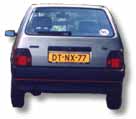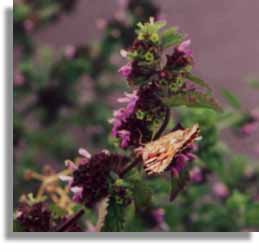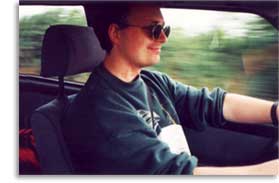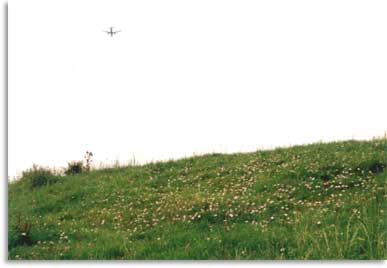Vortigern
Studies Index










.Wansdyke Project 21
is part of
Vortigern Studies

|
|
A
Visit to Wansdyke - Maes Knoll
  After 1989, 1992 and 1994, this was my fourth visit to
Wansdyke. Actually, the first two did hardly count for
anything, as you can read for yourselves. But then, two
years ago I had vowed to come back and re-shoot my sadly
failed pictures (though the scanner salvaged a little
bit). This year I had read everything scientific that had
been published - archaeology, survey, landscape, history
- all about the Dyke. For this reason I had planned to
see West Wansdyke as well. After 1989, 1992 and 1994, this was my fourth visit to
Wansdyke. Actually, the first two did hardly count for
anything, as you can read for yourselves. But then, two
years ago I had vowed to come back and re-shoot my sadly
failed pictures (though the scanner salvaged a little
bit). This year I had read everything scientific that had
been published - archaeology, survey, landscape, history
- all about the Dyke. For this reason I had planned to
see West Wansdyke as well.
 The holidays had started out
pleasant enough with a week near Worcester, from where we
visited 'Shakespeare-City' (commonly known as
Stratford-on-Avon) in blistering heat. We made some trips
to Hereford and Worcester, but also to Wales and the
'City of the Legions' (Caerleon), where at the 'FWRRWM'
(yes, that means Forum in Welsh, meaning here
the local Arts & Crafts shop) the famous dr. Russell
Rhys (click here to enlarge) severely tempted me
to take a seat in a 'Goblin's throne'! Thanks, but no
thanks, I'd rather stick to Arthurian matter and other
stuff one can be sure about.. If you're interested in all
the Roman stuff there, I'm preparing another site about
those, sorry. The holidays had started out
pleasant enough with a week near Worcester, from where we
visited 'Shakespeare-City' (commonly known as
Stratford-on-Avon) in blistering heat. We made some trips
to Hereford and Worcester, but also to Wales and the
'City of the Legions' (Caerleon), where at the 'FWRRWM'
(yes, that means Forum in Welsh, meaning here
the local Arts & Crafts shop) the famous dr. Russell
Rhys (click here to enlarge) severely tempted me
to take a seat in a 'Goblin's throne'! Thanks, but no
thanks, I'd rather stick to Arthurian matter and other
stuff one can be sure about.. If you're interested in all
the Roman stuff there, I'm preparing another site about
those, sorry.
  We were now in our second week of
the holidays, staying just north of the somewhat
depressed town of Frome, where we had lodgings in an old
watermill ('Jeffrey's Mill') with a beautiful garden
along the river Frome. Speaking of spirits, we had
visited Glastonbury the day before in beautiful weather,
though we were struck by the economic changes in the
area. Where there had been few shops apart from the ever
present alternative ones,we found these had been driven
from the High street in favor of the more financially
capable sects (Maytrea might not be an
omnipresent god/prophet, he/she/it does have very big
investors!). But we were not in such high spirits (no pun intended) anyway, because of Philippine's
severe morning sickness (click here to enlarge). Expecting a baby
can be very exciting, but there tend to be at least some
setbacks. One We were now in our second week of
the holidays, staying just north of the somewhat
depressed town of Frome, where we had lodgings in an old
watermill ('Jeffrey's Mill') with a beautiful garden
along the river Frome. Speaking of spirits, we had
visited Glastonbury the day before in beautiful weather,
though we were struck by the economic changes in the
area. Where there had been few shops apart from the ever
present alternative ones,we found these had been driven
from the High street in favor of the more financially
capable sects (Maytrea might not be an
omnipresent god/prophet, he/she/it does have very big
investors!). But we were not in such high spirits (no pun intended) anyway, because of Philippine's
severe morning sickness (click here to enlarge). Expecting a baby
can be very exciting, but there tend to be at least some
setbacks. One  of these is an absolute lack of
appetite, which leaves you without energy or the ability
to enjoy the holiday... Anyway, the town was still very
pleasant in this our third visit, which means that
whenever we're in the area, I guess a fourth visit is in
the cards.. of these is an absolute lack of
appetite, which leaves you without energy or the ability
to enjoy the holiday... Anyway, the town was still very
pleasant in this our third visit, which means that
whenever we're in the area, I guess a fourth visit is in
the cards..
That
morning we set out across the back roads north of Frome
to Radstock. The road took us to the southern outskirts
of the City of Bristol, over which towers the ancient
hillfort of Maes Knoll (197m). This iron Age fort was
refurbished in the later Roman period, after which it
became the most western point of Wansdyke.

Lying on the top of maes Knoll, an aircraft
buzzes overhead on its way to Bristol
|
|
 We parked the car along Norton
Lane, after which I took the small, steep track
to the summit. Wansdyke crosses Norton Lane below
the fort, and can be seen crossing the next two
fields in the direction of Publow Hill, where it
vanishes. We parked the car along Norton
Lane, after which I took the small, steep track
to the summit. Wansdyke crosses Norton Lane below
the fort, and can be seen crossing the next two
fields in the direction of Publow Hill, where it
vanishes.
The
Dyke is far less impressive here than the
Wiltshire or East Wansdyke section. The main
reason for this difference is not a different
building scheme (as
|
has been suggested), but a different type
of soil, which is much more fertile than the chalky Downs
to the east. As a result, Wansdyke has unfortunately been
ploughed down along large stretches, and is sometimes
downright invisible as a result. This becomes much
clearer when you climb Maes Knoll itself.
 The path up Maes Knoll is
difficult, and I must warn you of barbed wire and
agressive deer, but on reaching the top, the track simply
vanishes in the grass and you'll have to fend for
yourselves. I must advise anyone to not needlessly
aggravate the landowner and keep to the side of the fort,
even if that means you'll have to make quite a detour.
The views from Maes Knoll are a reason in itself to
attempt a visit. You'd best start at the large
blocking wall, also known as Maes Knoll Tump, on
the northwestern corner of the hillfort. This is
considered to have been the real end of Wansdyke,
blocking any access from the west. The views here are
spectacular; the Avon valley to the north, Bath to the
east, the Mendips south and maybe Bristol Channel west of
you. Small wonder why the builders of Wansdyke chose this
hillfort as their main aligning point. The path up Maes Knoll is
difficult, and I must warn you of barbed wire and
agressive deer, but on reaching the top, the track simply
vanishes in the grass and you'll have to fend for
yourselves. I must advise anyone to not needlessly
aggravate the landowner and keep to the side of the fort,
even if that means you'll have to make quite a detour.
The views from Maes Knoll are a reason in itself to
attempt a visit. You'd best start at the large
blocking wall, also known as Maes Knoll Tump, on
the northwestern corner of the hillfort. This is
considered to have been the real end of Wansdyke,
blocking any access from the west. The views here are
spectacular; the Avon valley to the north, Bath to the
east, the Mendips south and maybe Bristol Channel west of
you. Small wonder why the builders of Wansdyke chose this
hillfort as their main aligning point.

click here
for enlargement
In this spread, you can see the Mendips and
the Chew valley lakes to the south, while the ridge
plateau of Dundry Hill is to the west. The sprawl of
modern Bristol dominates the view north.
Though the
northern slope is overgrown with trees, it is quite clear
how the old wall was exchanged for a new one, that was in
turn connected with the Dyke at a certain point.

There are
still some stones to be found, not belonging to Wansdyke
but to the Iron Age wall. Unfortunately, Wansdyke is much
too overgrown to examine properly. It remains unclear if
Wansdyke really used the Tump and the north
banks, or that it started on the east slope, not using
but only touching the defences. I found some stones on
the north-eastern shoulder, but I couldn't say if these
belonged to the ancient circuit or more modern
activities.

click here for enlargement
In the above spread, you can see this corner
being cut-off, the original defences running along the
hedgerow.
Either these defences were changed during
the Iron Age, or maybe they were only upgraded during
sub-Roman times, at which time Wansdyke was constructed
as well. The point of junction between Wansdyke and Maes
Knoll is right below the rampart (see map left), where
the ditch (with no longer a bank attached) peters out.

for
enlargement, click here
In this spread, you see the original
defences following the hedgerow, but Wansdyke starts to
the right, where the fence ends and the shrub begins.

click here
for enlargement
In this spread, you can see that Wansdyke
due east of the Whitchurch - Norton Malreward road,
following the hedgerow to the little wood in the middle
distance, where it is crossed by the former railroad. In
the left corner lies Publow Hill.
 When you visit Maes Knoll, you
really should visit Stanton Drew as well. This ancient
monument might not be as impressive as Stonehenge or
Avebury, it is larger than the latter and consists of
more than three circles! And not unimportantly, you won't
find the massive crowds that the others are associated
with. The peace and quiet makes this monument, which you
can actually see from the summit of Maes Knoll, well
worth visiting. The cicles can be accessed from a small
car-park, which is well-signposted in the north of the
village (click here to enlarge). The circles are not
very well-defined, so you'll need a map to determine if
you're actuall in the Great Circle, or the NE or the SW
smaller circles which adjoin it. The stones are of a
reddish-brown colour, which seems quite odd at first. When you visit Maes Knoll, you
really should visit Stanton Drew as well. This ancient
monument might not be as impressive as Stonehenge or
Avebury, it is larger than the latter and consists of
more than three circles! And not unimportantly, you won't
find the massive crowds that the others are associated
with. The peace and quiet makes this monument, which you
can actually see from the summit of Maes Knoll, well
worth visiting. The cicles can be accessed from a small
car-park, which is well-signposted in the north of the
village (click here to enlarge). The circles are not
very well-defined, so you'll need a map to determine if
you're actuall in the Great Circle, or the NE or the SW
smaller circles which adjoin it. The stones are of a
reddish-brown colour, which seems quite odd at first.

click
here for enlargement
In this spread, you can see the view to the
north of the Neolithic (2500-2000 BC) Megalithic Stone
Circles of Stanton Drew. Maes Knoll is left on the
horizon.
 And of course I really should
mention the local pub (the 'Druids' Arms), where you can
easily visit another part of this great 'Henge'. This is
the 'Cove' (click here to enlarge), which you'll find
by starting back to the village and following the road
south, until you see the pub. The monument, consisting of
three stones, is right in the picknick-area! Also, you'll
find good food and drink there, not unimportant on a
day's outing! And of course I really should
mention the local pub (the 'Druids' Arms), where you can
easily visit another part of this great 'Henge'. This is
the 'Cove' (click here to enlarge), which you'll find
by starting back to the village and following the road
south, until you see the pub. The monument, consisting of
three stones, is right in the picknick-area! Also, you'll
find good food and drink there, not unimportant on a
day's outing!
And while
you're there, don't forget to support the local
farmers: order a nice lump of British beef! (Of course,
you might be a vegetarian..) No, I'm not British,
actually (Dutch and proud of it  ),
but we all want to preserve the British countryside and
its ),
but we all want to preserve the British countryside and
its  working
inhabitants, don't we? (Click here to enlarge) working
inhabitants, don't we? (Click here to enlarge)
Enough with
politics. We went home after a good meal and on to
Oxford, and of course the final visit to East Wansdyke in Wiltshire.
|